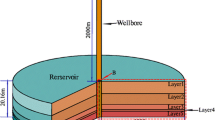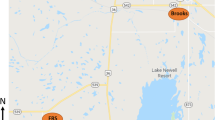Abstract
We present a numerical analysis of the sensitivity of the density driven CO2 convection results in a vertical Hele-Shaw cell with respect to different modeling assumptions. The role of density driven convection phenomenon in CO2 geological storage capacity and safety has already been pointed out in several studies. We showed that in order to accurately simulate the phenomenon occurring in lab experiments, multi-phase transfer has to be considered and variations in the permeability field should also be taken into account. Taylor dispersion has been found to have no significant effect on the results. Experimental results of the convection fingering process development and of quantitative determination of the total mass of dissolved CO2 were used to validate the numerical simulation results. Understanding how accurate numerical models can simulate lab experiments is an important step in confirming their reliability to predict underground CO2 storage capacity.






Similar content being viewed by others
Abbreviations
- b :
-
Hele-Shaw cell aperture (m)
- D :
-
Diffusion coefficient (m2/s)
- D Tay :
-
Taylor dispersion coefficient (m2/s)
- g :
-
Acceleration of gravity (m/s2)
- h :
-
Diffusive layer thickness (m)
- h c :
-
Pressure head difference between phases (m)
- H :
-
Hele-Shaw cell height (m)
- J :
-
Diffusive flux (kg/m3s)
- k :
-
Intrinsic permeability (m2)
- k r :
-
Relative permeability (−)
- m :
-
Van Genuchten third parameter (−)
- m d :
-
Mass rate density (kg/sm3)
- n :
-
Van Genuchten second parameter (−)
- M :
-
Molecular weight (kg/kmol)
- P :
-
Pressure (Pa)
- S :
-
Saturation (−)
- S el :
-
Effective water saturation (−)
- S r :
-
Irreducible water saturation (−)
- t :
-
Time (s)
- t conv :
-
Onset time of convection (s)
- U :
-
Average velocity in the flow direction (m/s)
- V :
-
Advective flux (m/s)
- W :
-
Hele-Shaw cell width (m)
- z :
-
Unit gravitation direction vector
- atm :
-
Atmospheric
- l :
-
Aqueous
- g :
-
Gas
- i :
-
H2O or CO2
- α :
-
Van Genuchten first parameter (−)
- ϕ :
-
Porosity (−)
- γ :
-
Phase index (liquid or gaseous)
- ρ :
-
Density (kg/m3)
- τ :
-
Tortuosity (−)
- μ :
-
Viscosity (Pa s)
- ω :
-
Mass fraction (−)
- χ :
-
Mole fraction (−)
References
Ennis-King J, Paterson L (2005) Role of convective mixing in the long-term storage of carbon dioxide in deep saline formations. Soc Petrol Eng J 10:349–356
Kneafsey TJ, Pruess K (2010) Laboratory flow experiments for visualizing carbon dioxide-induced density-driven brine convection. Transp Porous Med 82:123–139
Kneafsey TJ, Pruess K (2011) Laboratory experiments and numerical simulation studies of convectively enhanced carbon dioxide dissolution. In: Proceedings of the GHGT-10 conference, energy procedia 4:5114–5121
Faisal TF, Chevalier S Sassi M (2013) Experimental and Numerical studies of density driven natural convection in saturated porous media with application to CO2 geological storage. In: Proceedings of the GHGT-11 conference, energy procedia 37:5323–5330
Xu X, Chen S, Zhang D (2006) Convective stability analysis of the long-term storage of carbon dioxide in deep saline aquifers. Adv Water Resour 29:397–407
Riaz A, Hesse M, Tchelepi HA, Orr FM (2006) Onset of convection in a gravitationally unstable diffusive boundary layer in porous media. J Fluid Mech 548:87–111
Javaheri M, Abedi J, Hassanzadeh H (2010) Linear stability analysis of double-diffusive convection in porous media with application to geological storage of CO2. Transp Porous Med 84:441–456
Pau GSH, Bell JB, Pruess K, Almgren AS, Lijewski MJ, Zhang K (2010) High-resolution simulation and characterization of density-driven flow in CO2 storage in saline aquifers. Adv Water Resour 33:443–455
Slim AC, Ramakrishnan TS (2010) Onset and cessation of time-dependent dissolution-driven convection in porous media. Phys Fluids 22:124103
Pruess K (2008) Numerical modeling studies of the dissolution-diffusion-convection process during CO2 storage in saline aquifers, Lawrence Berkeley National Laboratory. http://www.escholarship.org/uc/item/2fc5v69p. Accessed 6 April 2014
Battistelli A, Claudio C, Pruess K (1997) The simulator TOUGH2/EWASG for modelling geothermal reservoirs with brines and noncondensible gas. Geothermics 26:437–464
Hidalgo JJ, Carrera J (2009) Effect of dispersion on the onset of convection during CO2 sequestration. J Fluid Mech 640:441–452
Farajzadeh R, Salimi H, Zitha PLJ, Bruining H (2007) Numerical simulation of density-driven natural convection in porous media with application for CO2 injection projects. Int J Heat Mass Transf 50:5054–5064
Farajzadeh R, Ranganathan P, Zitha PLJ, Bruining J (2011) The effect of heterogeneity on the character of density-driven natural convection of CO2 overlying a brine layer. Adv Water Resour 34:327–339
Ranganathan P, Farajzadeh R, Bruining H, Zitha PLJ (2012) Numerical simulation of natural convection in heterogeneous porous media for CO2 geological storage. Transp Porous Med 95:25–54
Farajzadeh R, Zitha PLJ, Bruining H (2009) Enhanced mass transfer of CO2 into water: experiment and modeling. Ind Eng Chem Res 48:6423–6431
White MD, Watson DJ, DH Bacon, White SK, McGrail BP, Zhang ZF (2012) STOMP, subsurface transport over multiple phases, STOMP-CO2 and -CO2e Guide, PNNL-21268, U.S. department of ENERGY, pp 270
Spycher N, Pruess K, Ennis-King J (2003) CO2–H2O mixtures in geological sequestration of CO2. I. Assessment and calculation of mutual solubilities from 12 to 100 C and up to 600 bar. Geochim Cosmoschim Acta 67:3015–3031
Alendal G, Drange H (2011) Two-phase near-field modeling of purposefully released CO2 in the ocean. J Geophys Res 106(C1):1085–1096
Kumagai A, Yokoyama C (1999) Viscosities of aqueous NaCl solutions containing CO2 at high pressures. J Chem Eng Data 44:227–229
Renner TA (1988) Measurement and correlation of diffusion coefficients for CO2 and rich-gas applications. SPE Reserv Eng 3:517–523
Li B, Tchelepi HA, Benson SM (2013) The influence of Capillary entry-pressure representation on CO2 solubility trapping. In: Proceedings of the GHGT-11 conference, energy procedia 37:3808–3815
Detwiler RL, Rajaram H, Glass RJ (2000) Solute transport in variable-aperture fractures: an investigation of the relative importance of Taylor dispersion and macrodispersion. Water Resour Res 36:1611–1625
Boschan A, Charette VJ, Gabbanelli S, Ippolito I, Chertcoff R (2003) Tracer dispersion of non-Newtonian fluids in a Hele-Shaw cell. Phys A 327:49–53
Bontoux N, Pepin A, Chen Y, Ajdari A, Stone HA (2006) Experimental characterization of hydrodynamic dispersion in shallow microchannels. Lab Chip J 6:930–935
Detwiler RL, Pringle SE, Glass RJ (1999) Measurement of fracture aperture fields using transmitted light: an evaluation of measurement errors and their influence on simulations of flow and transport through a single fracture. Water Resour Res 35:2605–2617
Faisal TF, Chevalier S, Bernabe Y, Juanes R, Sassi M (2015) Quantitative and qualitative study of density driven CO2 mass transfer in a vertical Hele-Shaw cell. Int J Heat Mass Transf 81:901–914
Acknowledgments
We would like to acknowledge Masdar Institute for the financial support of this collaboration project with MIT, Dr. Mark White from Pacific Northwest National Laboratory for his help with the STOMP simulator as well as Dr. Mohamed Mekias for his support in computational issues.
Author information
Authors and Affiliations
Corresponding author
Rights and permissions
About this article
Cite this article
Chevalier, S., Faisal, T.F., Bernabe, Y. et al. Numerical sensitivity analysis of density driven CO2 convection with respect to different modeling and boundary conditions. Heat Mass Transfer 51, 941–952 (2015). https://doi.org/10.1007/s00231-014-1466-2
Received:
Accepted:
Published:
Issue Date:
DOI: https://doi.org/10.1007/s00231-014-1466-2




